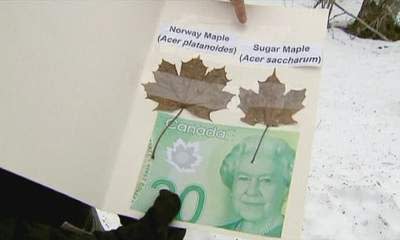Bank Of Canada Notes Use 'Wrong' Maple Leaf

The Bank of Canada blundered by using a Norwegian maple leaf instead of the country's native variety on its new banknotes, plant experts have claimed.
Atlantic Canada Conservation Data Centre botanist Sean Blaney highlighted the difference between the leaf on new \$20, \$50 and \$100 notes and the North American sugar maple.
He said: "It's really hard to deny the image is of a Norway maple."
He said the Norway maple has more lobes - or sections - has a more pointed outline than the sugar maple and the lobe that rises in the centre is shorter than the sugar maple's.
The Norway maple was imported from Europe and is now also common in North America. But Mr Blaney said it should not be on the Canadian currency.
"We wouldn't think of putting a palm tree on the Canadian currency or a tiger or baboon or something that doesn't occur in Canada as a native species, and the same should go for Norway maple," he added.
Canada's central bank said the image on the new bills was purposefully designed not to represent any specific species, but rather to be a combination of various kinds.
But another expert criticised the bank's move.
"I would have said immediately that it would be best to make it look more like a native maple leaf. I mean this to me is just ... wrong," said Julian Starr, a botany professor at the University of Ottawa.
The banknotes' designers created the image with the help of a dendrologist, a botanist who specialises in trees and shrubs.
The Bank of Canada had to apologise in August after it emerged that it had replaced the picture of an Asian lab assistant on its new \$100 banknote with a woman who looked more Caucasian.

 Yahoo News
Yahoo News 